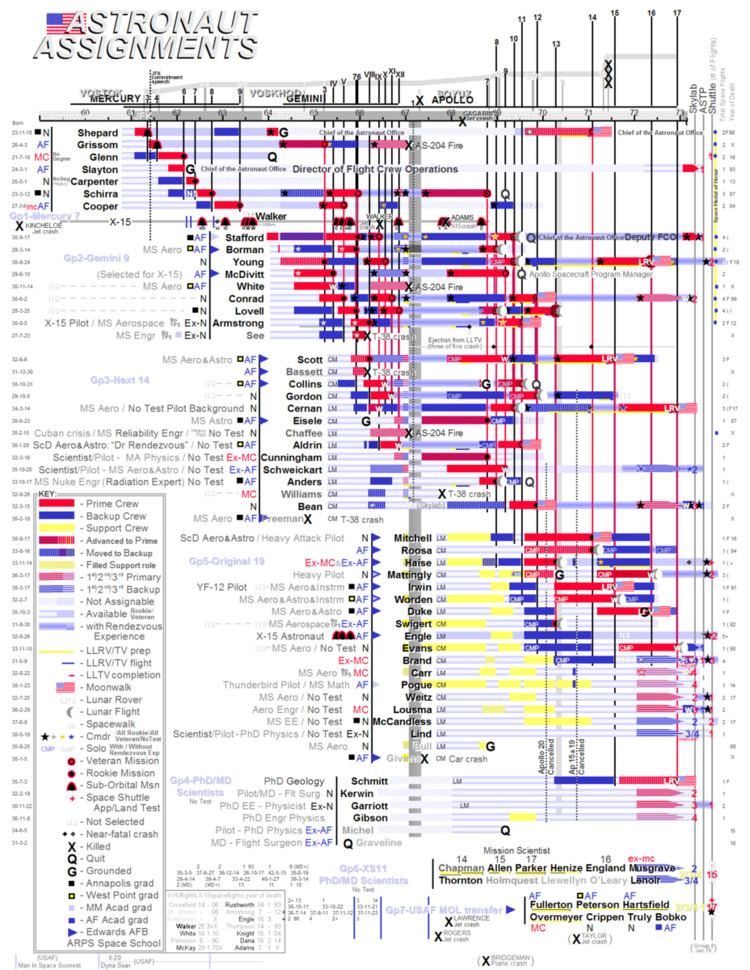Astronaut Group 7, referred to in some documents as the USAF MOL Transfer, was announced by NASA on August 14, 1969, and was the last group to be selected during the Apollo era. After the USAF Manned Orbiting Laboratory (MOL) project was cancelled, NASA hired seven of the astronauts selected for that program to form this "Group 7", roughly the younger half of the MOL astronauts. By the time they joined NASA, all Apollo flight assignments had been lined up, but four were given non-flying support assignments for Apollo. Others were also given support assignments for Skylab and the Apollo-Soyuz Test Project, with Bobko and Crippen participating in the Skylab Medical Experiment Altitude Test. Group 7 went on to form the core of early Space Shuttle pilots, upgrading to commander after their first flight, flying 17 STS missions between them, plus the Approach and Landing Tests of Enterprise (OV-101).
Karol J. Bobko (born 1937), U.S. Air Force (3 flights)STS-6 Challenger — April 1983 — Pilot — Maiden flight of
Challenger, TDRS A satellite deployment missionSTS-51-D
Discovery — April 1985 — Commander — Anik C-1 and Syncom IV-3 satellite deployment mission, first politician in spaceSTS-51-J
Atlantis — October 1985 — Commander — Maiden flight of
Atlantis, classified United States Department of Defense mission; DSCS-III satellite deployment
Robert L. Crippen (born 1937), U.S. Navy (4 flights)STS-1 Columbia — April 1981 — Pilot — First Space Shuttle mission, maiden flight of
Columbia, orbital test flightSTS-7
Challenger — June 1983 — Commander — Anik C-2 and Palapa B1 satellite deployment mission, first American woman in spaceSTS-41-C
Challenger — April 1984 — Commander — Long Duration Exposure Facility deployment and Solar Max repair missionSTS-41-G
Challenger — October 1984 — Commander — Earth Radiation Budget Satellite deployment mission, first spacewalk by an American woman, first Canadian astronautCrippen would eventually serve as director of the John F.
Kennedy Space Center.
C. Gordon Fullerton (1936–2013), U.S. Air Force (2 flights + ALT)ALT
Enterprise — February through October 1977 — PilotSTS-3
Columbia — March 1982 — Pilot — Research and development flightSTS-51-F
Challenger — July 1985 — Commander —
Spacelab pallet mission
Henry W. Hartsfield, Jr (1933–2014), U.S. Air Force (3 flights)STS-4 Columbia — June 1982 — Pilot — Final research and development flight, first classified United States Department of Defense payloadSTS-41-D
Discovery — August 1984 — Commander — Maiden flight of
Discovery, SBS-D, Telstar 3C, and Syncom IV-2 satellite deployment missionSTS-61-A
Challenger — October 1985 — Commander —
Spacelab mission
Robert F. Overmyer (1936–1996), U.S. Marine Corps (2 flights)STS-5 Columbia — November 1982 — Pilot — SBS-C and Anik C-3 satellite deployment missionSTS-51-B
Challenger — April 1985 — Commander — Spacelab mission
Donald H. Peterson (born 1933), U.S. Air Force (1 flight)STS-6 Challenger — April 1983 — Mission Specialist — Maiden flight of
Challenger, TDRS A satellite deployment mission
Richard H. Truly (born 1937), U.S. Navy (2 flights + ALT)ALT
Enterprise — February through October 1977 — PilotSTS-2
Columbia — November 1981 — Pilot — Remote Manipulator System testingSTS-8
Challenger — August 1983 — Commander — INSAT-1B satellite deployment mission, first night launch and night landing of the ShuttleTruly would later serve as Administrator of NASA.

